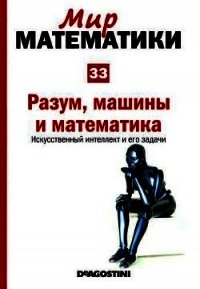Искусственный интеллект. Этапы. Угрозы. Стратегии - Бостром Ник (книги читать бесплатно без регистрации TXT) 📗
Isaksson 2007 — Isaksson Anders. Productivity and Aggregate Growth: A Global Picture. Technical report 05/2007. Vienna, Austria: UNIDO (United Nations Industrial Development Organization) Research and Statistics Branch, 2007.
Jones 2009 — Jones Garret. Artificial Intelligence and Economic Growth: A Few Finger-Exercises, 2009, January (Unpublished manuscript. Retrieved 2012, November 5; http://mason.gmu.edu/~gjonesb/AIandGrowth).
Jones 1985 — Jones Vincent C. Manhattan: The Army and the Atomic Bomb. United States Army in World War II. Washington, DC: Center of Military History, 1985.
Joyce 1999 — Joyce James M. The Foundations of Causal Decision Theory. Cambridge Studies in Probability, Induction and Decision Theory. New York: Cambridge University Press, 1999.
Judd et al. 2012 — Judd K. L., Schmedders K., Yeltekin S. Optimal Rules for Patent Races // International Economic Review, 2012, 53 (1), p. 23–52.
Kalfoglou et al. 2004 — Kalfoglou A., Suthers K., Scott J., Hudson K. Reproductive Genetic Testing: What America Thinks. Genetics and Public Policy Center, 2004.
Kamm 2007 — Kamm Frances M. Intricate Ethics: Rights, Responsibilities, and Permissible Harm. Oxford Ethics Series. New York: Oxford University Press, 2007.
Kandel et al. 2000 — Principles of Neural Science / Eds. Eric Kandel, James Schwartz, Thomas Jessell. 4th ed. New York: McGraw-Hill, 2000.
Kansa 2003 — Kansa Eric. Social Complexity and Flamboyant Display in Competition: More Thoughts on the Fermi Paradox, 2003 (Unpublished manuscript, archived version).
Karnofsky 2012 — Karnofsky Holden. Comment on «Reply to Holden on Tool AI» // Less Wrong (blog), 2012, August 1.
Kasparov 1996 — Kasparov Garry. The Day That I Sensed a New Kind of Intelligence // Time, 1996, March 25, no. 13.
Kaufman 2011 — Kaufman Jeff. Whole Brain Emulation and Nematodes // Jeff Kaufman’s Blog (blog), 2011, November 2.
Keim et al. 1999 — Keim G. A., Shazeer N. M., Littman M. L., Agarwal S., Cheves C. M., Fitzgerald J., Grosland J., Jiang F., Pollard S., Weinmeister K. Proverb: The Probabilistic Cruciverbalist // Proceedings of the Sixteenth National Conference on Artificial Intelligence. Menlo Park, CA: AAAI Press, 1999, p. 710–717.
Kell et al. 2013 — Kell Harrison J., Lubinski David, Benbow Camilla P. Who Rises to the Top? Early Indicators // Psychological Science, 2013, 24 (5), p. 648–659.
Keller 2004 — Keller Wolfgang. International Technology Diffusion // Journal of Economic Literature, 2004, 42 (3), p. 752–782.
KGS, 2012 — KGS Game Archives: Games of KGS player zen19 // KGS Go Server, 2012 (Retrieved 2013, July 22; http://www.gokgs.com/gameArchives.jsp? user=zen19d&oldAccounts=t&year=2012&month=3).
Knill et al. 2000 — Knill Emanuel, Laflamme Raymond, Viola Lorenza. Theory of Quantum Error Correction for General Noise // Physical Review Letters, 2000, 84 (11), p. 2525–2528.
Koch et al. 2006 — Koch K., McLean J., Segev R., Freed M. A., Berry M. J., Balasubramanian V., Sterling P. How Much the Eye Tells the Brain // Current Biology, 2006, 16 (14), p. 1428–1434.
Kong et al. 2012 — Kong A., Frigge M. L., Masson G., Besenbacher S., Sulem P., Magnusson G., Gudjonsson S. A., Sigurdsson A. Rate of De Novo Mutations and the Importance of Father’s Age to Disease Risk // Nature, 2012, 488, p. 471–475.
Koomey 2011 — Koomey Jonathan G. Growth in Data Center Electricity Use 2005 to 2010. Technical report, 08/01/2011. Oakland, CA: Analytics Press, 2011.
Koubi 1999 — Koubi Vally. Military Technology Races // International Organization, 1999, 53 (3), p. 537–565.
Koubi, Lalman 2007 — Koubi Vally, Lalman David. Distribution of Power and Military R&D // Journal of Theoretical Politics, 2007, 19 (2), p. 133–152.
Koza et al. 2003 — Koza J. R., Keane M. A., Streeter M. J., Mydlowec W., Yu J., Lanza G. Genetic Programming IV: Routine Human-Competitive Machine Intelligence. 2nd ed. Genetic Programming. Norwell, MA: Kluwer Academic, 2003.
Kremer 1993 — Kremer Michael. Population Growth and Technological Change: One Million B.C. to 1990 // Quarterly Journal of Economics, 1993, 108 (3), p. 681–716.
Kruel 2011 — Kruel Alexander. Interview Series on Risks from AI // Less Wrong Wiki (blog), 2011 (Retrieved 2013, Oct. 26; http://wiki.lesswrong.com/wiki/Interview_series_on_risks_from_AI).
Kruel 2012 — Kruel Alexander. Q&A with Experts on Risks From AI #2 // Less Wrong (blog), 2012, January 9.
Krusienski, Shih 2011 — Krusienski D. J., Shih J. J. Control of a Visual Keyboard Using an Electrocorticographic Brain-Computer Interface // Neurorehabilitation and Neural Repair, 2011, 25 (4), p. 323–331.
Kuhn 1962 — Kuhn Thomas S. The Structure of Scientific Revolutions. 1st ed. Chicago: University of Chicago Press, 1962.
Kuipers 2012 — Kuipers Benjamin. An Existing, Ecologically-Successful Genus of Collectively Intelligent Artificial Creatures. Paper presented at the 4th International Conference, ICCCI 2012, Ho Chi Minh City, Vietnam, 2012, November 28–30.
Kurzweil 2001 — Kurzweil Ray. Response to Stephen Hawking // Kurzweil Accelerating Intelligence, 2001, September 5 (Retrieved 2012, December 31; http://www.kurzweilai.net/response-to-stephen-hawking).
Kurzweil 2005 — Kurzweil Ray. The Singularity Is Near: When Humans Transcend Biology. New York: Viking, 2005.
Laffont, Martimort 2002 — Laffont Jean-Jacques, Martimort David. The Theory of Incentives: The Principal-Agent Model. Princeton, NJ: Princeton University Press, 2002.
Lancet, 2008 — Iodine Deficiency — Way to Go Yet // The Lancet, 2008, 372 (9633), p. 88.
Landauer 1986 — Landauer Thomas K. How Much Do People Remember? Some Estimates of the Quantity of Learned Information in Long-Term Memory // Cognitive Science, 1986, 10 (4), p. 477–493.
Lebedev 2004 — Lebedev Anastasiya. The Man Who Saved the World Finally Recognized // MosNews, 2004, May 21.
Lebedev, Nicolelis 2006 — Lebedev M. A., Nicolelis M. A. Brain-Machine Interfaces: Past, Present and Future // Trends in Neuroscience, 2006, 29 (9), p. 536–546.
Legg 2008 — Legg Shane. Machine Super Intelligence. PhD diss., University of Lugano, 2008.
Leigh 2010 — Leigh E. G., Jr. The Group Selection Controversy // Journal of Evolutionary Biology, 2010, 23 (1), p. 6–19.
Lenat 1982 — Lenat Douglas B. Learning Program Helps Win National Fleet Wargame Tournament // SIGART Newsletter, 1982, 79, p. 16–17.
Lenat 1983 — Lenat Douglas B. EURISKO: A Program that Learns New Heuristics and Domain Concepts // Artificial Intelligence, 1983, 21 (1–2), p. 61–98.
Lenman 2000 — Lenman James. Consequentialism and Cluelessness // Philosophy & Public Affairs, 2000, 29 (4), p. 342–370.
Lerner 1997 — Lerner Josh. An Empirical Exploration of a Technology Race // RAND Journal of Economics, 1997, 28 (2), p. 228–247.
Leslie 1996 — Leslie John. The End of the World: The Science and Ethics of Human Extinction. London: Routledge, 1996.
Lewis 1988 — Lewis David. Desire as Belief // Mind: A Quarterly Review of Philosophy, 1988, 97 (387), p. 323–332.
Li, Vitanyi 2008 — Li Ming, Vitaanyi Paul M. B. An Introduction to Kolmogorov Complexity and Its Applications. Texts in Computer Science. New York: Springer, 2008.
Lin et al. 2012 — Lin Thomas, Mausam, Etzioni Oren. Entity Linking at Web Scale // Proceedings of the Joint Workshop on Automatic Knowledge Base Construction and Web-scale Knowledge Extraction (AKBC-WEKEX ’12) / Eds. James Fan, Raphael Hoffman, Aditya Kalyanpur, Sebastian Riedel, Fabian Suchanek, Partha Pratim Talukdar. Madison, WI: Omnipress, 2012, p. 84–88.




